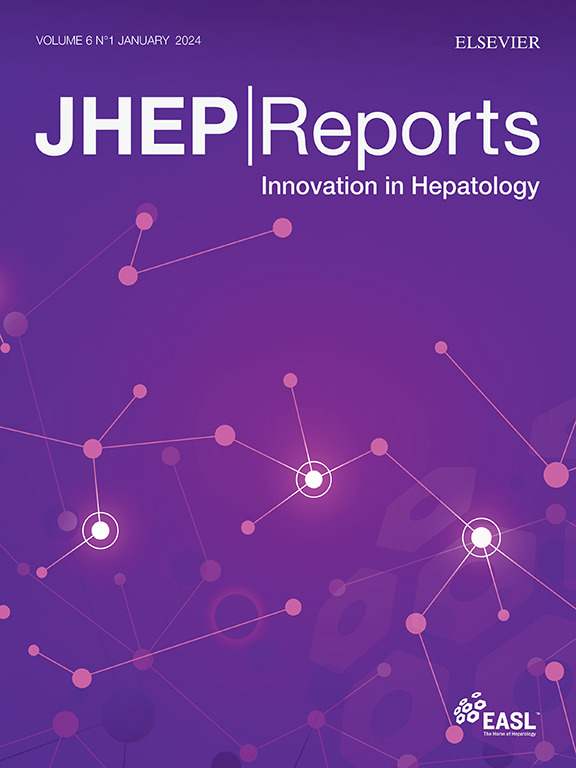代谢组学液体活检动力学预测早期HCC和人类肝癌发生的可行候选
IF 9.5
1区 医学
Q1 GASTROENTEROLOGY & HEPATOLOGY
引用次数: 0
摘要
背景,目的肝癌发生的可行候选因素仍然难以捉摸,早期检测的工具也不够理想。我们的目的是证明血清代谢组谱反映了肝细胞癌(HCC)的发生,并能够识别早期HCC检测的生物标志物和可操作的化学预防候选物。方法本研究纳入654例患者和801例生物标本。在整个肝癌发生谱的血清代谢组谱分析之后,我们进行了一项用于早期HCC检测的II期生物标志物病例对照研究。通过计算机分析、mRNA测序、原发性HCC和非肿瘤组织的蛋白质组分析以及体外实验,独立验证了研究结果。结果血清中天冬氨酸、谷氨酸、牛磺酸和次黄嘌呤含量在慢性肝病、肝硬化、原发性HCC和进展性HCC患者中存在差异,与性别、年龄和病因无关。在一项II期生物标志物病例对照研究中,基于血液的代谢物标记产生了94%的AUC,用于区分早期HCC患者和肝硬化对照组,包括独立验证。无监督双聚类(MoSBi)、脂质网络分析(LINEX2)和途径富集分析证实了氨基酸、脂质和核苷酸相关途径的改变。在肿瘤组织中,在两个独立的数据集中,包括可操作靶点RRM2、GMPS、BCAT1、PYCR2和NEU1,这些通路的基因和蛋白表达显著失调。体外敲除证实了其在增殖和迁移中的功能作用,如PYCR2。结论血清代谢组分析表明,在肝癌发生过程中,代谢物和途径的失调。我们的液体活检方法比目前推荐的监测工具更准确地检测早期HCC,并有助于确定可行的候选化学预防方法。影响和启示细胞代谢失调是癌症的一个标志。在较小规模的研究中,循环代谢物谱与HCC相关,尽管主要是在脂肪肝疾病的背景下。缺乏初级预防或早期发现的翻译策略。在这项全球研究中,我们呈现了肝癌发生过程中无监督的血清代谢组谱变化,与年龄、性别和病因无关。我们提供了一种基于血液的代谢物标记,在一项II期生物标志物研究中准确识别早期HCC,包括独立验证。此外,RRM2、GMPS、BCAT1、PYCR2和NEU1在肿瘤组织中被鉴定为可用于预防的候选药物。我们的数据为临床试验提供了基本原理,测试基于液体活检代谢组的特征,用于早期HCC检测和化学预防策略的发展。本文章由计算机程序翻译,如有差异,请以英文原文为准。

Metabolomic liquid biopsy dynamics predict early-stage HCC and actionable candidates of human hepatocarcinogenesis
Background & Aims
Actionable candidates of hepatocarcinogenesis remain elusive, and tools for early detection are suboptimal. Our aim was to demonstrate that serum metabolome profiles reflect the initiation of hepatocellular carcinoma (HCC) and enable the identification of biomarkers for early HCC detection and actionable candidates for chemoprevention.
Methods
This global cohort study included 654 patients and 801 biospecimens. Following serum metabolome profiling across the spectrum of hepatocarcinogenesis, we conducted a phase II biomarker case–control study for early HCC detection. Findings were independently validated through in silico analysis, mRNA sequencing, and proteome profiling of primary HCC and non-tumoral tissue, and in vitro experiments.
Results
Aspartic acid, glutamic acid, taurine, and hypoxanthine were differentially abundant in the serum across chronic liver disease, cirrhosis, initial HCC, and progressed HCC, independent of sex, age, and etiology. In a phase II biomarker case–control study, a blood-based metabolite signature yielded an AUC of 94% to discriminate between patients with early-stage HCC and controls with cirrhosis, including independent validation. Unsupervised biclustering (MoSBi), lipid network analysis (LINEX2), and pathway enrichment analysis confirmed alterations in amino acid-, lipid-, and nucleotide-related pathways. In tumor tissue, these pathways were significantly deregulated regarding gene and protein expression in two independent datasets, including actionable targets RRM2, GMPS, BCAT1, PYCR2, and NEU1. In vitro knockdown confirmed a functional role in proliferation and migration, as exemplified for PYCR2.
Conclusions
These findings demonstrate that serum metabolome profiling indicates deregulated metabolites and pathways during hepatocarcinogenesis. Our liquid biopsy approach accurately detects early-stage HCC outperforming currently recommended surveillance tools and facilitates identification of actionable candidates for chemoprevention.
Impact and implications
Deregulated cellular metabolism is a hallmark of cancer. In smaller studies, circulating metabolite profiles have been associated with HCC, although mainly in the context of fatty liver disease. Translation strategies for primary prevention or early detection are lacking. In this global study, we present an unsupervised landscape of the altered serum metabolome profile during hepatocarcinogenesis, independent of age, sex, and etiology. We provide a blood-based metabolite signature that accurately identifies early-stage HCC in a phase II biomarker study including independent validation. Further RRM2, GMPS, BCAT1, PYCR2, and NEU1 are identified in tumor tissue as actionable candidates for prevention. Our data provide the rationale for clinical trials testing liquid biopsy metabolome-based signatures for early HCC detection and the development of chemoprevention strategies.
求助全文
通过发布文献求助,成功后即可免费获取论文全文。
去求助
来源期刊

JHEP Reports
GASTROENTEROLOGY & HEPATOLOGY-
CiteScore
12.40
自引率
2.40%
发文量
161
审稿时长
36 days
期刊介绍:
JHEP Reports is an open access journal that is affiliated with the European Association for the Study of the Liver (EASL). It serves as a companion journal to the highly respected Journal of Hepatology.
The primary objective of JHEP Reports is to publish original papers and reviews that contribute to the advancement of knowledge in the field of liver diseases. The journal covers a wide range of topics, including basic, translational, and clinical research. It also focuses on global issues in hepatology, with particular emphasis on areas such as clinical trials, novel diagnostics, precision medicine and therapeutics, cancer research, cellular and molecular studies, artificial intelligence, microbiome research, epidemiology, and cutting-edge technologies.
In summary, JHEP Reports is dedicated to promoting scientific discoveries and innovations in liver diseases through the publication of high-quality research papers and reviews covering various aspects of hepatology.
 求助内容:
求助内容: 应助结果提醒方式:
应助结果提醒方式:


